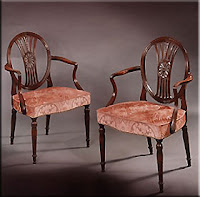Yes, my wonderful hosts at San Francisco (who were very sweet about their front room being turned into a slum) did have a bathtub, but I was too tired every night to do anything but wade through my belongings strewn all over the floor and drop into bed. I was also inspired by Elena’s post yesterday about her visit to Monticello to remember a well-kept secret in Bath County, Virginia–Thomas Jefferson’s warm springs. Elena, you must go there!
 In the accurately, if unimaginatively named town (I think it’s a town) of Warm Springs, VA, a couple of hours southwest of the Washington, DC metro area, you can bathe in true Regency (or federal) era style in natural 98-degree mineral water. Jefferson built the original men’s bathhouse in 1818–since it’s of wood, who knows how many times timbers have been replaced–and a women’s bathhouse was added, chastely next door, in 1836.
In the accurately, if unimaginatively named town (I think it’s a town) of Warm Springs, VA, a couple of hours southwest of the Washington, DC metro area, you can bathe in true Regency (or federal) era style in natural 98-degree mineral water. Jefferson built the original men’s bathhouse in 1818–since it’s of wood, who knows how many times timbers have been replaced–and a women’s bathhouse was added, chastely next door, in 1836.
 Now the baths are owned by a huge, luxurious resort up the road in Hot Springs, the Homestead, which has a rather different sort of bath (and all sorts of decadent goodies) and offers full spa services.
Now the baths are owned by a huge, luxurious resort up the road in Hot Springs, the Homestead, which has a rather different sort of bath (and all sorts of decadent goodies) and offers full spa services.
 But if you want the historical experience, go to Jefferson’s pools. The buildings are round wooden structures, open to the sky, and although they were probably used year-round in his time, now they’re only open in the summer. It’s very relaxing to float in the water–you can also ask the bath attendant to open the sluice while you sit in a sort of wooden channel and receive a water massage (there’s a continual flow of water in and out). According to this article, you can also have a natural ginseng massage.
But if you want the historical experience, go to Jefferson’s pools. The buildings are round wooden structures, open to the sky, and although they were probably used year-round in his time, now they’re only open in the summer. It’s very relaxing to float in the water–you can also ask the bath attendant to open the sluice while you sit in a sort of wooden channel and receive a water massage (there’s a continual flow of water in and out). According to this article, you can also have a natural ginseng massage.
Bathing suits are optional–my husband reported that all the guys were stark naked (of course). In the women’s house, lithe young things in bathing suits looked on in horror as women of a certain age flaunted their scars, stretchmarks, flab etc.
Here’s more information on Bath County, Virginia.
Do you have any hot water, natural, au naturel, or other, experiences you’d like to share? Your favorite, hidden-away spot somewhere?
















